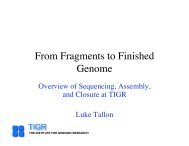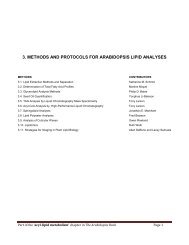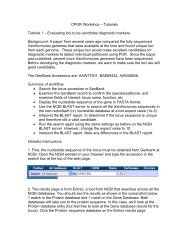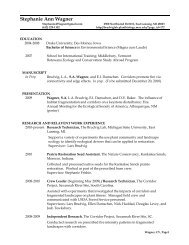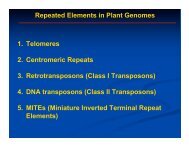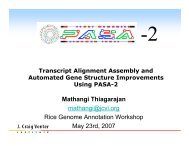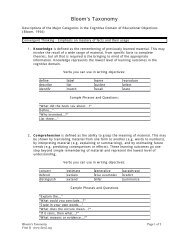1 Cell Biology TL Unit Contributors:
1 Cell Biology TL Unit Contributors:
1 Cell Biology TL Unit Contributors:
You also want an ePaper? Increase the reach of your titles
YUMPU automatically turns print PDFs into web optimized ePapers that Google loves.
<strong>Cell</strong> <strong>Biology</strong> <strong>TL</strong> <strong>Unit</strong><br />
<strong>Contributors</strong>:<br />
Stephanie Aamodt, Beverly Clendening, Hans Landel, and John Rebers, Doug Luckie (facilitator)<br />
Course Description:<br />
Introduction to <strong>Cell</strong> and Molecular <strong>Biology</strong>. An introductory course for science majors (generalizable to<br />
non-major courses; other courses in major). Enrollment of 50-200 students.<br />
Concept<br />
<strong>Unit</strong> covered is cell structure<br />
Learning Goals/Objectives:<br />
After completing this unit the student will:<br />
• Describe cellular organization and the way this organization relates to function<br />
o Describe the spatial and temporal organization of different types of cells<br />
o Relate the organization of the cell to different functional activities<br />
• Compare and contrast the organization of living and non-living objects<br />
At the end of the course, the student will:<br />
• Describe the hierarchal organization of living things, including the following levels:<br />
o Chemical/molecular<br />
o <strong>Cell</strong>ular/organelle<br />
o Tissue/organ/system<br />
o Organisms/ecosystems<br />
Rationale for Instructional Approach:<br />
Student misconception: Students often think of the cell as a static, two-dimensional collection of<br />
independent parts. Students memorize the names and definitions of the parts without understanding the<br />
function or interrelationships of these parts.<br />
The expert view of the cell recognizes that cells have dynamic spatial and temporal organization that is<br />
important for function.<br />
This lesson plan uses model-based reasoning and inquiry for students to develop skills and knowledge<br />
they can apply later to understand the hierarchal organization of living things. The same approach could<br />
be used for other systems, including physiology and ecosystems.<br />
This unit will help students understand cellular organization. We begin by using organization of a familiar<br />
machine, followed by the organization of the human body, to model the way that organization is required<br />
for function. Students then use active learning processes to model the organization of cellular components<br />
(molecules and organelles) and develop ideas about the way this organization is related to function.<br />
FIRST National Meeting 2005 1<br />
Kellogg Biological Station<br />
Executive Summary
Brief Description of the <strong>TL</strong> <strong>Unit</strong>:<br />
This <strong>TL</strong> <strong>Unit</strong> emphasizes scale and function to emphasize the dynamic nature of cell organelles<br />
in one to two fifty minute classes. Students start by exploring the importance of the spatial and<br />
temporal relationship among parts of a tree. The process is then repeated for a root and leaf cell.<br />
To reinforce and assess understanding, students label a cell diagram with the functions of cell<br />
organelles and build a concept map emphasizing the functional relationships between cell parts.<br />
How Does the <strong>TL</strong> <strong>Unit</strong> Address Active Learning?<br />
• Group discussions relate parts of complex systems (car, human body) to the need for organization<br />
(static and dynamic) to produce a functioning system<br />
o For both car and human body:<br />
Students use think/pair/share to develop list of parts<br />
Informal groups are used to relate parts to function<br />
Class discussion relates organization of overall system to function<br />
• Students individually are responsible for developing list of cell parts<br />
• Informal groups are used to relate parts of cells to functions<br />
• Students use concept mapping to relate ideas of static and dynamic organization to show how cell<br />
parts are organized and interact<br />
• “perturb and predict” activities stress critical thinking and allow assessment and reinforcement<br />
FIRST National Meeting 2005 2<br />
Kellogg Biological Station<br />
Executive Summary
<strong>Cell</strong> <strong>Biology</strong> <strong>TL</strong> <strong>Unit</strong><br />
Brief Description of the <strong>TL</strong> <strong>Unit</strong><br />
Class Process:<br />
1. What must a tree have to produce apples? Draw a model of an apple tree with all possible parts<br />
labeled.<br />
a. GROUP WORK: groups of 3 or 4<br />
b. Draw a model of an apple tree labeling all possible parts. The model should<br />
illustrate how the parts work together to help the tree produce apples.<br />
The model should have<br />
- Parts labeled<br />
- Functions identified for each of the parts<br />
- Arrows showing how resources ( water, CO 2 , sugar etc. ) are transported<br />
2. Now use the model to help make an apple.<br />
a. GROUP WORK (part 2):<br />
b. Integrate all of the parts and processes of the model together into a logical sequence of<br />
events to make an apple.<br />
c. example: model illustrates water (and nutrient) acquisition by roots, transport of water<br />
through trunk and stems to leaves, diffusion of CO 2 into leaf, photosynthesis with CO 2<br />
and light in leaf, transport of sugar to flower and apple. The model can be more complex,<br />
but this simple model will help them start to integrate processes<br />
3. Assess understanding to this point: “perturb and predict” by having students develop scenarios<br />
where 1) spatial and 2) temporal organization are perturbed effecting function.<br />
a. GROUP WORK: groups of 3 or 4<br />
b. You have an apple tree in your yard. Most years you have more apples than you<br />
can eat. This year there was a drought and it appears that there are only a few<br />
small apples on your tree. The some leaves have turned red and others have fallen<br />
off the tree even though it is only mid August.<br />
- Using your model, describe the processes and parts that might have<br />
reduced apple production?<br />
c. Selected groups present model as instructor builds class consensus model for apple tree.<br />
4. FOCUS—Bring to cell level<br />
a. GROUP WORK: groups of 3 or 4<br />
b. Simultaneously repeat steps 1-3 for a leaf cell and a root cell. The two cells will help<br />
identify differences in function and help connect from the cellular to the organismal<br />
scale.<br />
5. Mini-lecture on one cell organelle as illustration of how students should approach the material<br />
a. Vote to decide which organelle to “uncover” first<br />
b. re-emphasize organization concepts while doing this—connections, processes<br />
FIRST National Meeting 2005 1<br />
Kellogg Biological Station<br />
<strong>Unit</strong> Description
6. Homework (critical thinking + assessment)<br />
a. concept map – functional organization of cell parts<br />
b. graphic – unlabeled cell diagram, label parts with functions, not names<br />
c. Process – Using your concept map, predict what would happen if a particular<br />
perturbation in a process occurs. Show where this perturbation occurs.<br />
Grading Rubric – <strong>Cell</strong> <strong>Biology</strong> Concept Map<br />
1. 5 pts<br />
a. All assigned concepts listed included<br />
b. Relationships between terms shown clearly using appropriate<br />
connecting words<br />
c. Network of relationships between ideas clearly shown<br />
d. All significant relationships shown<br />
2. 4 pts<br />
a. All assigned terms included<br />
b. Relationships between terms shown clearly using appropriate<br />
connecting words<br />
c. Not all important relationships between concepts indicated<br />
3. 3 pts<br />
a. All assigned terms included<br />
b. Relationships between terms not shown clearly, or inappropriate<br />
connecting words used<br />
c. Network of relationships between ideas not shown clearly<br />
4. 2 pts<br />
a. Not all assigned terms included<br />
b. Relationships between terms not shown clearly, or inappropriate<br />
connecting words used<br />
c. Network of relationships between ideas not shown clearly<br />
FIRST National Meeting 2005 2<br />
Kellogg Biological Station<br />
<strong>Unit</strong> Description
Homework<br />
A. Label all of the organelles and functions discussed in class on the figure below. Draw<br />
additional lines as needed.<br />
B. Quickly discuss why this is a leaf cell or a root cell? What organelles and<br />
processes would differ between the two cells?<br />
C. Use all of the organelles discussed in class to create a concept map illustrating the<br />
functional relationship between the parts of a cell.<br />
D. Using your concept map, predict what would happen if a particular perturbation in<br />
a process occurs.<br />
FIRST National Meeting 2005 3<br />
Kellogg Biological Station<br />
<strong>Unit</strong> Description
Eukaryotic <strong>Cell</strong> Organization:<br />
Breaking the Jell-O Salad<br />
Mold<br />
Stephanie Aamodt, LSU-Shreveport<br />
Beverly Clendening, Hofstra Univ.<br />
Hans Landel, Edmonds Community College<br />
Doug Luckie, MSU<br />
John Rebers, Northern Michigan University
Description of the Challenge<br />
Our group: <strong>Cell</strong>/Developmental <strong>Biology</strong><br />
Target: introductory biology course, majors or nonmajors,<br />
of any size<br />
The Misunderstanding: the eukaryotic cell is a collection<br />
of individual and isolated parts, randomly arranged in the<br />
cell<br />
The “Jell-O Salad” paradigm<br />
You will see later what we want students to think instead<br />
the “Jell-O Salad” model (what our objectives are) because<br />
we do not want to prejudice you, but we can tell you:<br />
Emphasis on model-based reasoning, relying on analogy<br />
Specific objectives are in our course description document
Learning Goals/Objectives<br />
After completing this unit the student will:<br />
• Be able to describe cellular organization and the way this<br />
organization relates to function<br />
• Be able to relate the organization of the cell to different<br />
functional activities<br />
• Be able to make reasonable assumptions about the reasons for<br />
differences between prokaryotic and eukaryotic cells<br />
At the end of the course, the student will:<br />
• Be able to apply the idea that function is dependent on<br />
organized structure to the organization of living things,<br />
including the following levels:<br />
o Chemical/molecular<br />
o <strong>Cell</strong>ular/organelle<br />
o Tissue/organ/system<br />
o Organisms/ecosystems
Preliminaries<br />
Before this class<br />
Preliminary introduction to macromolecules<br />
Class discussion: Define “living things” and generate<br />
list of requirements<br />
Introduce cells as the “smallest unit of life”<br />
All cells have membrane, DNA, cytoplasm
“The class part”<br />
Run through first part of class
Summary<br />
Car is organized<br />
parts<br />
subsystems<br />
systems<br />
connections<br />
Organization is important to function<br />
Car has processes<br />
simultaneous<br />
connections<br />
Processes important to function<br />
Processes and Organization are interdependent
“The FIRST part”<br />
Describe rest of class
TRANSITION: Bring the Class to<br />
<strong>Biology</strong><br />
have been examining a non-living object<br />
let’s use what we have learned about the car to<br />
examine a living object -- the human body
TRANSITION: Bring the Class to<br />
<strong>Biology</strong><br />
The procedures with the car has served as a model for what<br />
we would like the students to do.<br />
Car will serve as an analogy<br />
Now use the same procedure as with the car, but with the<br />
human body<br />
list functions body must perform to live<br />
list body parts<br />
categorize body parts according to function<br />
parts must be assembled in correct locations<br />
certain activities must occur for body to function<br />
may or may not include formative assessment by performing<br />
“perturb and predict” exercises
Concept Maps<br />
NOTE: Homework (assessment) will include<br />
concept mapping of cell parts with respect to<br />
function<br />
If students have not been introduced to concept<br />
maps, a good place to introduce them is at the<br />
point when they are asked to categorize the parts<br />
of the body according to function. This will<br />
model for them what we would like them to do in<br />
the homework assignment.
Possible example concept map: plants
Example of a poor concept map<br />
“Sentence-in-a-box”<br />
Poor concept map<br />
Good concept map<br />
should show complex<br />
relationships<br />
One part can have<br />
multiple relationships<br />
Use linking terms to<br />
show how parts are<br />
related<br />
Focus on most<br />
important connections
FOCUS: Bring the class to<br />
the cell level<br />
Important transition<br />
Have established a context for<br />
describing and understanding the cell
Break the “Jell-O salad mold”<br />
More than a boring parts list<br />
Structures are not isolated; they are<br />
interconnected<br />
Structures are not randomly placed; they are<br />
highly organized<br />
The organization is not static; it is dynamic
Repeat steps 1 through 3<br />
Ask the class to list functions cell must<br />
perform to live, and the parts of the cell<br />
Can the students group the parts according<br />
to function?<br />
Can the students organize the parts of the<br />
cell? Make connections?
Recognize that student<br />
knowledge is limited<br />
Students will have some prior knowledge,<br />
but it will be simple, pat definitions.<br />
Allow class to explicitly identify what they<br />
don’t know or understand.<br />
Emphasize that what we don’t know as a<br />
class will direct the rest of the unit.
Model a dynamic view of the cell<br />
Present an exciting mini-lecture on one cell<br />
structure or organelle as an example for the class.<br />
Include a video clip of a cell process such as<br />
mitosis or transport or a cell in motion.<br />
Describe how the structure is made of smaller<br />
parts that fit together precisely to allow a specific,<br />
controlled process<br />
(Here, “model” means showing students what we<br />
expect them to do)
Encourage students to think<br />
The contextual framework will be<br />
reinforced by homework and assessments.<br />
The dynamic, highly organized view of life<br />
will be further developed in classes on<br />
cellular respiration, mitosis and most other<br />
topics, as well, as the course continues into<br />
the study of cell biology.
Assignment<br />
1. Complete the structure/function chart for the cell<br />
that was begun in class. The information can be<br />
found in Chapter x of your textbook.<br />
• this forces the students to learn the parts on their<br />
own, but within the context of function
2. Draw a concept map that shows the spatial and<br />
functional relationships among<br />
nucleus<br />
endoplasmic reticulum<br />
ribosomes<br />
mitochondria<br />
cytosol<br />
synthesis of macromolecules (anabolic metabolism)<br />
breakdown of macromolecules for energy production<br />
(catabolic metabolism)<br />
Examples of connecting phrases (is connected to, takes<br />
place in , etc.)<br />
this assesses their understanding of the concepts of<br />
spatial and temporal organization
3. Label the cell compartments with their functions.
4. Predict, in detail, what would happen if<br />
Group A<br />
• there was a hole in the cell membrane.<br />
• the cell had no mitochondria.<br />
• a mature cell lost its nucleus.<br />
Group B<br />
• none of the ribosomes were attached to the endoplasmic<br />
reticulum.<br />
• the process of vesicle formation could not occur (the Golgi<br />
apparatus could not form vesicles).<br />
Pick one from Group A and one from Group B<br />
this assesses their understanding of the importance<br />
of spatial and temporal organization of cells
The EXCITING significance of<br />
this unit<br />
It covers a BIG idea in <strong>Biology</strong><br />
It is “scalable” for use in other topics
The Big Idea<br />
Living Things Are Organized.<br />
Spatially- certain parts are located in certain<br />
places<br />
Temporally - certain processes take place in<br />
a certain order<br />
Function is dependent on both spatial and<br />
temporal organization<br />
Interconnected<br />
Interactions<br />
Hierarchical (systems, subsystems, subsubsystems<br />
. . .)
Permeation of the “Big Idea”<br />
you can (and we think you should) re-examine the<br />
importance of spatial and temporal organization<br />
when the following cellular topics are discussed<br />
Metabolism<br />
Mitosis<br />
Protein synthesis<br />
Intracellular signaling<br />
Intercellular signaling<br />
our assessments can be used after any of these<br />
topics, and in midterm and final exams
“Active Transport” of the “Big Idea”<br />
The Big Idea applies (by definition) to all levels of<br />
biology. We think it should be continually<br />
stressed.<br />
• Macromolecules<br />
• Organelles<br />
• Tissues<br />
• Organs<br />
• Organisms<br />
• Communities<br />
• Ecosystems
Scalability of Exercise<br />
Because life is hierarchically organized,<br />
with each level exhibiting spatial and<br />
temporal organization (i.e., because it is a<br />
Big Idea), this exercise can be used at any<br />
level.<br />
(it has wide applicability)
Living things are organized.<br />
Replace “Living Things” with . . .<br />
• Macromolecules<br />
• Organelles<br />
• Tissues<br />
• Organs<br />
• Organisms<br />
• Communities<br />
• Ecosystems
Revisions?<br />
Feedback from FIRST participants suggests<br />
Transition (human body) step can be left out<br />
Car analogy has sexual bias -- women will<br />
have a harder time relating to it<br />
• we had discussed this and had decided to address<br />
this by calling on women first<br />
• also, you can use ANY object you would like as<br />
your analogy, as long as it it sufficiently complex,<br />
has processes, and is understandable by the<br />
majority of your students (see course description<br />
document)



